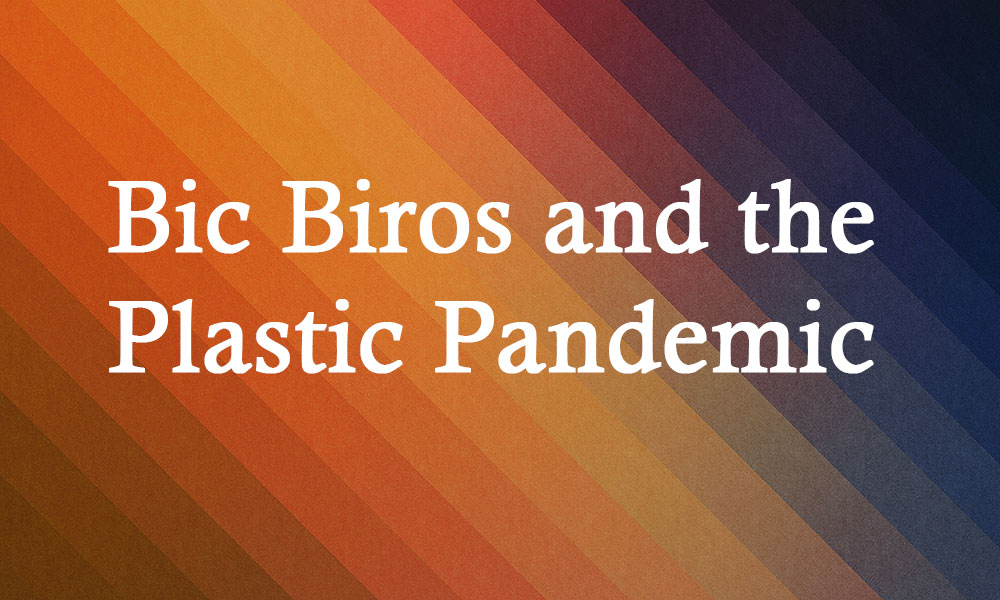Bic Biros, the first ball point pen, were not just novel icons of functional simplicity they were the first objects of plastic I encountered, a true, almost pure, innocent when considered against the present plastic pandemic, the tide of plastic that washes our waterways and seas.
Of course, we weren’t allowed to use biros. Censorious educators believed they would cruel the careful copperplate of legible handwriting. Having a ‘good hand’ was an indication of sober accomplishment. To ensure this worthy aim, pencils were imposed until graduation in primary school to “The Dip Pen”. This was a wooden stylus into which was inserted a steel nib that was finely slit with a small hole that held the ink. This ensured, from constant cramped use, an index finger with an enlarged lump stained permanently blue.
The apex of acceptance was to be Ink Monitor, responsible for carefully mixing the powdered ink in a bottle with a rubber bung with two duct tubes, one slightly shorter than the other. A finger over one hole carefully regulated the flow of ink distributed to ink wells in the right-hand corner of desks around the room, strategically placed that way to discourage use of the left hand. Which would confound a ‘good hand’. And probably induce homosexuality which was equally to be discouraged.
The school barracks were graded according to ability from A down to GA, the General Activities class of the academically challenged, sentenced to gardening. Pinioned as far from view as possible, the GA room was an altar to upended authority. The towering wooden ceiling was studded with Dip Pens surrounded by spidery filaments of splattered ink and blob blotches created by chewed paper spit balls catapulted to the ceiling from rulers anchored to the edge of the desk. What was noticeable was the use of wax papered milk straws jammed on the end of the stylus adding flight stability to Dip Pens hurtling towards the ceiling. Who said they were stupid? And what’s more creative too.
The waxed paper straws were significant, doled out each morning at recess with a quarter pint of school milk. This was delivered each morning and stored in the shade. There was no refrigeration so as the morning curdled a thick crust of cream settled on the top. Pasteurised to avoid TB transmission but certainly not homogenised, the milk was indigestible and only reluctantly consumed under the censorious eye of older Milk Monitors.
This was a time when infant health was a central Public Concern and every suburb had a Child Health or Truby King Centre where new borns, particularly of “the poor”, were compulsorily weighed, checked and vaccinated. School milk logically followed as a calcium supplement – against rickets in children and penury among dairy farmers. In some places like Tasmania morning recess was accompanied by an apple and an Oslo sandwich: the apple to strengthen youngsters’ teeth and the Huon apple industry; the Oslo sandwich to add iodine to the diet against endemic goitre – and to aid bakers and the grain industry.
It was a time of unapologetic social engineering for the Public Good and public support for a hive of industries. Everything was prefaced with Public, all of capitalised importance, and governments were seen as the logical and necessary providers of these amenities – electricity and water, roads and rail, telephone and the PMG, the monolithic Post Master General’s Department. Later sewerage was added and Gough Whitlam’s boast was he left the nation “fully flushed”. No private provider would touch these services of course, because they were simply unprofitable, with the lead-time to profitable return measured in decades. If it were not for this public investment we would still be on tank water, stumbling in the dark to outside dunnies and watching TV by candlelight.
The outside dunny was an institution that led each summer to a wave of hepatitis spread by swarms of flies through the suburbs. Noticeable was the paper accompaniment, either carefully torn newspaper in convenient squares or a telephone book with a hole drilled in one corner and a piece of coarse string threaded through and looped over a nail. There would have been no fighting in the aisles over toilet paper as occurred in the recent pandemic.
And dunny man was an honourable profession. We all speculated in school about future jobs and one of my primary school cobbers was adamant he would be a dunny man. His dad was a dunny man and the terms of employment were tempting. His dad rose before sparrow’s fart to do his rounds and was back by early morn with the rest of the day free. For this he was well paid, given a shower at the end of his shift and a fresh outfit. A permanent job and steady income what more could any person want? Permanent jobs, of course, have gone the way of the dunny man.
The dunny man was so much a part of the world as children it did no register except when something exceptional occurred. Like when the dunny cart broke down on the road where we were all playing cricket with an upturned garbage bin for a wicket, which would Toll for Thee if bonged by the ball. The dunny cart was a two-tiered arrangement smelling more of the tar and creosote used to coat the cans than urine and excrement. The cart had a flat tyre and in order to lighten the load to jack the vehicle the cans were unloaded and lined like a long line of sentinels along the edge of the road. As this was taking place two of our local spinsters – you don’t hear that term any more – walking along, propped and queried with concern, “Dear me what seems to be the problem?” Without even a flicker of humour the driver replied, “We’re doing a stock take and we’re one turd short.” As kids in short pant we were mightily impressed at this laconic response.

